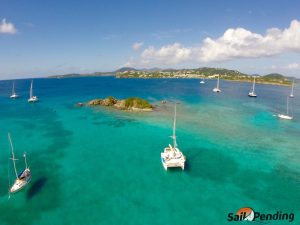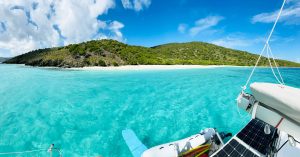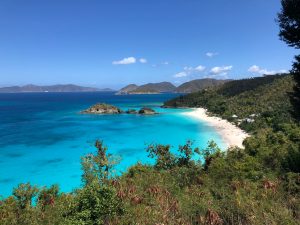Keys or Cays?

Keys & Cays of the Virgin Islands
Ahoy! And welcome aboard! When people think of the Virgin Islands, their minds naturally drift towards the larger islands like St. Thomas, St. John, Tortola and Virgin Gorda but numerous smaller islands, islets and cays comprise the territory as well. In total, some 90 tiny outcroppings of land, sand and rocks fill the 60-mile stretch known as the Virgin Islands which begins about 40 to 50 miles east of Puerto Rico and heads into the Caribbean Sea.
Some fifty small cays and islands lie within the boundaries of the U.S. Virgin Islands alone. Because these small islands and their surrounding waters are home to various seabirds, lizards, turtles and corals, 33 offshore cays are protected by the U.S. Fish and Wildlife Service and designated as wildlife sanctuaries. The National Park Service also lends its hand in helping to protect many of these areas. There are also a handful of tiny islands that are privately owned. All of this means that visiting the various keys and cays depends upon how each small island is classified. Some classifications prohibit visitors, some require special permits, while others have no restrictions and welcome visitors.
“Toe-may-toe” or “Toe-mah-toe?”
Pronunciation is everything, right? So is “key” pronounced the same as “cay?” And what’s the difference between the two anyway? Let’s clear up the confusion! While Virgin Islanders prefer to say the word “Key” as though it’s spelled like “Cay,” according to the lexicon gods, pronunciation of the word “cay” is acceptable whether it sounds like ‘key’ or the letter ‘K.’ And, either word means: “a tiny, low-lying sandy island or reef.” While the U.S. mainland prefers to designate these areas as “keys,” the term “cay” is mainly used in the Caribbean, thanks to Spanish explorers and settlers who used the term. So remember, if you want to talk like a local, say the word “Key” as though it’s spelled like “cay.”
Let’s Get Acquainted – A Few Cays Worth Knowing
East End, St. Thomas
Cas Cay – Also known as “Happy Island,” this cay can only be reached by boat or kayak. Situated on the east end of St. Thomas, Cas Cay is a pristine deserted island. VI Eco Tours offers guided hikes to this little gem where you’ll see tidal pools, volcanic cliffs, and a geological blowhole at Red Joint that takes small waves and blasts them over tidal pools. Great photo ops await in every direction so click away!. Sign up for a VI Eco Tour and you’ll get the added bonus of kayaking through the mangrove waterways leading to Cas Cay, not to mention a guided snorkel in the clear, protected waters offshore. Definitely a fun adventure and look for the hermit crabs that call this cay home.
Dog Island – Not much to see here as it’s a small, uninhabited slip of land owned by the U.S. Virgin Islands government that’s located east-southeast of Little Saint James. The two islands are separated by the Dog Island Cut.

Christmas Cove
Great St. James & Little Saint James – Unfortunately, these two small private islands have been steeped in controversy thanks to its former owner. Today, billionaire Stephen Deckoff owns both Little St. James and Great St. James and plans to turn both islands into a world-class resort. Look for the flamingos that once congregated on the island, though many have recently wandered further away to the shores of St. John. Also of note is the world famous Pizza boat, otherwise known as Pizza Pi, which resides in Christmas Cove where there is a shipwreck and several reefs worth exploring. IF you want to visit the St. James islands, we have 2 scheduled trips that visit these islands several times a week.
Shark Island – Standing on Sapphire Beach, you can see this small rocky islet situated 0.3 miles northeast of Prettyklip Point on St. Thomas. This spec of land that’s only 32 feet high is home to numerous seabirds and a favorite spot for scuba-diving. Hire a boat charter to drop you off and escort you home for an adventurous afternoon.
Northside, St. Thomas
Hans Lollik Islands – These two islands are privately owned, purchased in 2014 for $23 million by Larry Page. Great Hans Lollik Island is separated from St. Thomas by the Leeward Passage and Little Hans Lollik lies to the north of Hans Lollik. From the early 18th century to the 1850s, the islands were clear-cut and farmed for cotton. Surrounding the islands lies a diverse coral habitat that attracts a variety of fish. This is also a great place to enjoy the beach all to yourself and a popular stop on a private USVI trip.

Inner & Outer Brass – These undeveloped islands consists of 130 acres and can be reached by kayaking or boating from St. Thomas. It’s known for its white sandy beaches, tropical reefs and caves. Paddling out to both Inner & Outer Brass from Hull Bay on St. Thomas is an fun all-day adventure, but always pay attention to the strength of winds and currents to ensure a safe trip.
Southside, St. Thomas
Buck Island and Capella Island – Buck Island, home to Buck Island National Wildlife Refuge, is only accessible by private boat or through a tour guide licensed by the National Park Service. Known as one of the most important beaches for nesting hawksbill sea turtles, the island also serves as nesting grounds for many species of local and migratory birds. Capella Island, which is half the size of its adjacent neighbor Buck Island, consists of 230 undeveloped acres.
Hassel Island – This small island consisting of 136 acres lies in the Charlotte Amalie harbor south of St. Thomas and east of Water Island. Once a peninsula of St. Thomas, known as Orkanhullet or Hurricane Hole, Hassel Island was separated by the Danish government in 1860 and named for the Hassel family who owned much of the estate. More recently, in 2012, the island was noted as the location for the filming of the TV series The Real World. More of a secluded National Park than up-and-coming resort locale, Hassle Island boasts only a handful of homes. St. Thomas Historical Trust offers frequent tours to this island.Check out their website for the schedule.
Saba Island – Three miles south of Cyril E. King Airport, Saba Island’s rocky shores rise out of the ocean some 200 feet at its peak. There is a sandy beach on the northern side and Turtledove Cay, another small islet, is connected via a shallow sandbar. Salt ponds on the eastern and western sides of Saba Island attract numerous birds and snorkelers, as well as scuba divers who love exploring the various shipwrecks offshore. If you visit, check out the Saba Rock Resort, where day trippers and guests can splurge on luxurious spa treatments, world-class culinary offerings and a variety of water activities.
Northern Cays of the Pillsbury Sound (These Cays, which separate the Atlantic Ocean from the Caribbean Sea, are really special and the snorkeling is amazing!) Listed East to West:
Carval Rock – This uninhabited islet appeared in the premiere episode of The Amazing Race 25, where the 11 competing teams had to climb across the top of the rock before jumping off into the ocean. Cliff jumping is still a popular activity here as is scuba diving. Folklore has it that Carvall Rock was used as target practice long ago, because sea vessels were unable to clear into the Danish West Indies if they had any live ammunition on board. Sailors and pirates would unload their ammunition at Carval Rock before going ashore.
Lovango Cay – This private island in the district of St. John consists of 118 acres. A 10-minute boat ride from St. John or St. Thomas can drop you at the Lovango Resort & Beach Club where upscale amenities await. You can even spend the night, choosing from villas with pools, cottages with outdoor showers or various “glamping” options. Waterfront dining, hiking, playing chess with life-size pieces, shopping or lounging poolside at the Lovango Cay Beach Club are all options while on the island. Join our USVI Island Hop & Food Tour to experience Happy Hour at Lovango Cay.
Congo Cay – Is a wildlife refuge and bird sanctuary located North of Lovango Cay. Our crew usually reports spotting baby pelicans on this Cay. The small channel between Lovango and Congo is undoubtedly one of the most beautiful areas in the Virgin Islands. Many of the pictures of Stormy Pirates’ boats are pictured here. Another tidbit worth mentioning is that the ashes of J. Robert Oppenheimer are sunk between here, Lovango Cay and Carvel Rock.
Grass Cay – This cay is located between Mingo and Thatch and is approximately 1.6 miles long and only ⅛ of a mile wide. There is no permanent human habitation on the island but there are a couple of great dive sights.
Thatch Cay – This small, uninhabited island, comprising 230 acres, is located about ½ mile off of the northeastern end of St. Thomas. Its highest peak is a mere 482 feet high, and it’s one of the last privately held, undeveloped islands in the USVI and is currently for sale. Rumored Price is $29,000,000.00
Named after the Tyre palms which are found in dense pockets on the island, the cay was first owned by the Reyck family from Denmark, who operated a small plantation called, “The Hope,” consisting of 14 family members and two slaves. By the mid 1900s, the area was home to a small fishing village and a small copper mine. Visit the cay today and you’ll see remnants of the stone structures that once existed on the island. Snorkel the waters surrounding the cay and you might just see some of the Panulirus argus lobsters that seem to thrive in the area.
In 2000, Thatch Cay was purchased by Scott McIntyre of Idealight VI LLC with plans for development of a luxury resort with eco-friendly designs and solar powered island-wide wireless networks. By 2003, the property was turned over to a San Diego firm which put the real estate back on the market. Currently, it’s still for sale. So if buying a piece of paradise is your dream, now’s your chance to make it a reality!
Northside, St. John
Waterlemon Cay – Located in Leinster Bay, Waterlemon Cay is a short swim from Leinster Point, which can be accessed via hiking the Leinster Bay Trail from the Annaberg Ruins parking area. (It’s roughly a 1-mile hike on a flat, though rocky, path). Considered one of the best snorkeling spots on St. John, the cay is a mix of seagrass, coral, sand and cobblestones. Visitors have seen everything from red starfish, tarpons and stingrays to sharks and the occasional octopus. Schools of fish are always present. One note of warning: during full moon phases, the tide can be strong so know your swimming limits.
Trunk Cay – This small, grass-covered islet sits in Trunk Bay a mere 200 feet from the beach. Because Trunk Bay is part of the Virgin Islands National Park, there is a nominal charge to enter the area, but you’ll get the bonus of showers, bathrooms, a snack bar, as well as snorkel & chair rentals. One unique feature is the self-guided Underwater Trail with information about the coral and sea life that exists next to the cay.
Whistling Cay – This 19-acre islet sits about 300 yards west of Mary Point on St. John. Its cliffs reach a 130-foot elevation and the cay is covered in trees. On the southeast side of the islet there’s a gravel beach. To get there, rent a kayak from Cinnamon Bay or Maho Bay. The water can be rough at times but the snorkeling can be exciting. Park your kayak on the rocky beach and don your masks and fins. The water is deep, so larger fish tend to gather in this spot, which also means a few opportunistic sharks are generally lingering nearby as well.
Cinnamon Cay – Only 100 yards from the shores of Cinnamon Beach, 32-feet-high Cinnamon Cay is mostly covered with grass and cactus. Part of the Virgin Islands National Park, the cay attracts snorkelers and divers. Cinnamon Bay Watersports offers kayaks and snorkeling equipment to make the trip more accessible if swimming isn’t your strong suit.
East End, St. John
Leduck Island (also spelled LeDuck) – Located 0.5 miles east of Sabbat Point in Johns Folly, Leduck Island lies by the entrance to Coral Bay and is 85 feet high. Leduck Island is one of St. John’s largest offshore islands, along with Grass Cay and Congo Cay. Because of its many spur and groove reefs which attract an abundance of endemic tropical fish, the island is popular with scuba divers and snorkelers. Some fish species that can be found here include Fairy basslet, Sergeant major, French Angelfish, Blue Chromis, snappers and Squirrelfish.
End Notes: Although there are more keys and cays scattered about, this list highlights enough spots of interest to get you started should you wish to go exploring. Talk to us at Stormy Pirates Charters and we’ll do our best to transport you to the cays that interest you the most. As always, feel free to share this blog with your friends. Then start planning a boat day that will make your Virgin Islands vacation extra special. Remember, our motto never changes: We’ll put the gang plate down and escort you in style!


